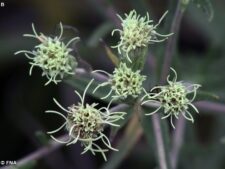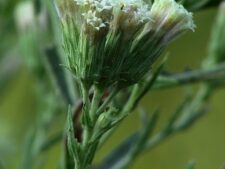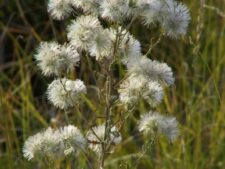
FALSE BONESET
Brickellia eupatorioides
SUNFLOWER FAMILY (Asteraceae)
 Identification
Identification
- Flowering time - August, September
- Common in prairies and old fields at NW
- Cream colored, "ragged" looking flower clusters
- Fuzzy, round seed heads
- See comments for separation from other plants with similar flower clusters
This native perennial grows 1-3 feet tall. The stem is unbranched except near the top where the flower clusters occur. Alternate, lance-shaped leaves up to 4” long have smooth to sparsely toothed margins. At the tips of the numerous upper branches are loose, flat to rounded clusters of cylindrical flowerheads bearing white to cream colored flowers (A). Each flowerhead has 7 to 30 cylindrical, 5-lobed disk flowers (C). Long styles protruding from the center give the flowerheads a rather ‘ragged’ look (A,B). Flowers mature into showy, rounded 3/4 inch balls of fuzzy, plumed fruits conspicuous long after the first frost (D).
False Boneset occurs in dry prairie uplands and old fields, flowering in August and September. It is common in the prairie restorations at Neale Woods. It has not been seen recently at Fontenelle Forest.
The species name for False Boneset, eupatorioides, originates from its resemblance to plants of the genus Eupatorium, many with similar flower heads. These include Boneset (Eupatorium perfoliatum), Tall Boneset (Eupatorium altissimum) and late boneset (Eupatorium serotinum), all occurring at FF/NW. False Boneset differs from those plants in that it is shorter, has alternate, one-veined leaves and showy plume-like seed heads. Another Eupatorium, White Snakeroot (Ageratina altissima), a woodland plant sometimes creeping into prairie edges, has much broader, opposite leaves and pure white flower heads.
This plant does not have the showy ray flowers we find in many other members of the Sunflower Family. Rather, the tiny 5 “petaled” flowers we see are actually disk florets like the just like those in the center of our yellow sunflowers.
The content of NatureSearch is provided by dedicated volunteer Naturalists of Fontenelle Forest who strive to provide the most accurate information available. Contributors of the images retain their copyrights. The point of contact for this page is: Roland Barth.



